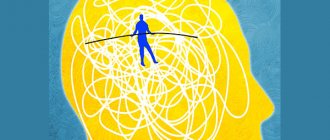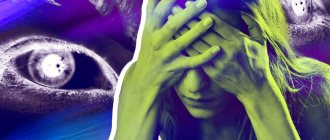Adolescence is a period of life when the formation of a person’s character traits occurs.
The child’s psyche at this moment is unstable and vulnerable. Modern teenagers are distinguished by their penchant for maximalism, demonstrative protest, and oppositional behavior. During adolescence, human emotions are very changeable and fickle. It is for this reason that some adolescents begin to develop primary mental disorders. Schizophrenia is one of the pathologies that rapidly develops at this stage.
For many, this mental disorder is associated with such unpleasant manifestations as:
- madness;
- antisocial behavior;
- maladjustment in society;
- insulation;
- no future.
To some extent this is true. Late diagnosed or advanced schizophrenia can lead to serious consequences. Fortunately, these are isolated cases.
Modern methods of diagnosing and treating mental disorders help patients lead a normal lifestyle without losing its quality.
The main task of parents of a teenager is to understand the reason for the change in behavior and seek help in time.
Causes of teenage schizophrenia
The main factor in the development of this mental disorder is heredity. Scientists have identified a number of genes that convey a predisposition to schizophrenia. But this is far from the only source of the disease.
Psychiatrists argue that there are also a number of biological and psychosocial prerequisites. Most often there are several triggers. The most common causes of schizophrenia in adolescents:
- parental divorce;
- frequent quarrels in the family;
- severe stress;
- any type of violence – physical, psychological, sexual;
- taking a large dose of alcohol or drugs for the first time;
- traumatic brain injury.
Statistics show that boys are diagnosed with schizophrenia twice as often as girls at the same age. The reason for this pattern is unknown.
Another scenario for the development of the disease
Symptoms of schizophrenia in adolescents may debut in a different way. It is based on the following changes:
- excessive cruelty;
- asociality;
- sexual liberation.
Cruelty and rudeness in behavior appear for no apparent reason. Often patients find inadequate explanations for them. So, a guy stabbed his mother several times because she didn’t cook him the dish he wanted.
Especially aggressiveness and cruelty are expressed in relation to animals: they beat them, kick them, hang them by their heads. The teenager tore off the heads of pigeons and collected them in a suitcase. He explained this by saying that he would feed them to the cats.
Increased sexuality is also an indicative symptom in adolescents with schizophrenia.
A 13-year-old boy stopped attending school. He showed rudeness towards his mother and other relatives, became unbalanced and hot-tempered. He claimed that he needed a woman. He stole valuables from the house and ran away, being absent for several days. He met a prostitute and had sexual intercourse with her. Gave her gold jewelry. He bought porn magazines and scattered them around the house.
Sexual attraction becomes characteristic, manifested in relation not only to strangers, but also to relatives. Boys often develop sexual attraction to their mother. Sexual perversions manifest themselves in the form of fetishism, masochism, and sadism.
At the beginning of the development of the disease, adolescents
become involved in antisocial groups whose members are older than them.
But such children cannot fully join the bandit group, remaining hermits in it. Their behavior is also unpredictable and strange. A young man tried to steal a car in order to go to prison. This manifested his desire to be like the leader of the criminal group of which he was a member - he had already had the sad experience of imprisonment in the past.
Abuse of alcohol and psychotropic drugs is commonplace for schizophrenic adolescents. Usually these addictions are particularly severe. But what is characteristic: despite high doses of alcohol, they practically do not experience withdrawal symptoms, and in case of drug addiction they are not clearly expressed. The patient is able to easily give up the addiction.
The pathological nature of behavior is also expressed in a combination of neatness and uncleanliness . Thus, a patient may walk around in dirty, worn-out clothes and not wash for weeks. But he eats with a knife and fork, constantly wiping himself with a napkin, observing all the rules of etiquette.
First manifestations
The initial signs of schizophrenia in a teenager can be noticed in childhood. But they are irregular and expressed sporadically, so parents attribute them to some individual character traits, fatigue or moodiness. Besides, it’s hardly anyone’s pleasure to suspect their own child has a mental disorder.
It will not be difficult to see changes in a child’s behavior if he led an energetic lifestyle: he studied well, actively communicated with friends, was interested in sports or other hobby activities. But suddenly some event occurs that radically changes his life. He ceases to be interested in studies, he does not find common topics for conversation with friends, he refuses to play sports or previously loved activities.
The teenager withdraws into himself, his behavior becomes unpredictable. The mood can change in the opposite direction in seconds.
The reason for visiting a psychiatrist should be the following, repeatedly occurring symptoms:
- Progressive ridiculous ideas and strange reasoning.
- Changes in the logic of thinking, transformation of speech.
- Craving for absurd fantasies, absurd philosophizing.
- Emotional alienation even from close people, absence or inconsistency of reaction to current events.
- Atypical and absurd use of words and expressions in conversation.
- Irritability for no apparent reason, deceit, manifestation of causeless aggression.
- Inactivity, apathy, lack of any initiative and interest in life.
- Tendency to alienate, categorical refusal to go out, neglect of personal hygiene, sloppiness, carelessness in clothing.
- Unusual phobias and fears, eating disorders, strange hobbies or accumulation of unnecessary things.
- Consumption of alcohol, drugs, tendency to vagrancy.
- Talk about suicide.
A rather characteristic manifestation of a mental disorder should be noted ostentatious hostility towards parents or one of them who was especially close.
Symptoms
The signs of schizophrenia in adolescents are not very different from its manifestations in adults. Most often this is the same delusion, hallucinations, personality disorder.
One can observe rudimentary delusional distortions of thinking in the form of various fears and phobias. They are intrusive and literally pursue the patient. Among them are:
- Fear of other people's parents. The child begins to suspect his own parents that they are not his own. He is afraid of them, does not make contact, and refuses to eat.
- Fear of contamination, which is often accompanied by compulsive hand washing. The teenager does this at every opportunity, regardless of his location.
- Fear of open space – agoraphobia. The patient wants to hide somewhere, to become invisible.
Attention should be paid to the adequacy of the child’s reaction. It happens that to a situation that should make a person sad or upset, he reacts with a fit of laughter and feigned fun. The most common emotional disorders are:
- fenced off;
- isolation;
- absence of any manifestations of emotions, monotonous reaction to events happening around;
- loss of interest in previously favorite activities.
On the part of motor disorders, there may be repeated stereotypical movements, freezing in some unnatural positions, poor posture, strange gait, etc. Sometimes the angularity and awkwardness of movements can be attributed to adolescence or the accelerated growth of a teenager. But this pattern only works if the child has only these manifestations and they do not get worse over time.
Features of a simple form
This form of clinical manifestations, especially at the onset of the disease, is similar to sluggish schizophrenia and some authors include it within the latter. In modern American psychiatry, along with pseudoneurotic and pseudopsychopathic, the simple form is generally removed from the list of schizophrenic disorders and classified as personality disorders [Lichko A. E., 1983].
However, the simple form differs significantly from the sluggish, steady progression and worse prognosis - an increase in the main symptoms of schizophrenia - emotional impoverishment, lack of initiative, inactivity, isolation and isolation from the environment, as well as formal thinking disorders.
Follow-up data indicate that even with intensive treatment, only 1/4 of patients experience long-term remissions. In other cases, a more or less pronounced schizophrenic defect develops or the disease passes into other progressive forms. More favorable catamnesis for the simple form were presented only by those authors who extremely expanded its boundaries, including, for example, neurosis-like and psychopath-like forms.
The simple form develops faster in adolescents than in adults. Often its typical manifestation at this age is preceded by a special period when, over the course of several months, changes in behavior are observed, as if in contrast to the classic symptoms. In this initial period, emotional lability, mood swings and a tendency to intense activities appear - they sit for many hours on lessons, or completely devote themselves to some hobby, or read voraciously. However, already during this period, affective reactions become unmotivated, and intensive training soon turns out to be unproductive.
Then, gradually or quite abruptly, a fracture occurs. Increasing emotional impoverishment is primarily reflected in cooling towards family and loved ones. Hostility can flare up precisely towards those family members to whom they were previously especially attached (in young men, often to their mother). Old interests fade away, studies are abandoned, old friends are lost. They spend time in idleness and are not drawn to their peers. The appearance of negligence and sloppiness in clothing soon reaches uncleanliness - they do not want to wash, they refuse to change their linen.
Contact becomes formal. Facial expressions lose their liveliness and subtle expressiveness. The voice becomes monotonous, devoid of emotional modulations. In one tone, as if on the same note, they speak about indifferent things and about things that should excite and touch. Painful experiences are extremely reluctant to share. Only sometimes they confirm the difficulty of concentrating, the feeling of emptiness in the head - “gaps in thoughts.” They are often wary when asked about ideas about attitudes or dysmorphomanic experiences, but they are not expressed. At the same time, questions about other topics of delirium (persecution, influence, etc.) are left completely indifferent. From hallucinatory experiences it is sometimes possible to identify the presence of episodic “calls” by name.
The described manifestations of the disease without active treatment tend to slowly but steadily increase, leading the patient to complete disability.
Other progressive forms with gradual onset in adolescence
Paranoid debuts. In adolescents, schizophrenia begins with a paranoid debut quite rarely - in 1-2% of cases, according to our data, and almost all cases fall in late adolescence. A. B. Smulevich I M. G. Shirina (1972 - cited in “Manual of Psychiatry...”, 1983) found that only 10% of the debuts of paranoid schizophrenia occur before the age of 20 years.
In the premorbid, features of epileptoid accentuation of character are noted, namely “hypersociality”, an emphasized desire to show oneself “correct” in all respects, and at the same time stubbornness, arrogance, overestimation of one’s own person, disregard for the interests of others and extreme attention to everything “one’s own” - things, affairs, interests, your personality as a whole. Such teenagers tend to accuse teachers of being unfair to them, of lowering their grades, and often convince their loved ones of this.
The delusional system is formed gradually. Its source is often previous hobbies - for example, participation in the work of a young technician's circle - for delusions of invention, passion for detective literature - for delusions of persecution. In other cases, the impetus may be mental trauma: the death of someone close from a serious illness - for a delusional belief in the presence of an incurable disease, etc. The “monothematic nature” of delusions and the absence of hallucinations are very characteristic.
Unlike adults, the paranoid debut in adolescents quickly turns into a paranoid form, and a different theme of delusion predominates. For example, one cannot see delusions of jealousy or litigious delusions. The most common types of paranoid delusions are:
Detective paranoid delusions manifest themselves in the fact that a teenager suspects one of his relatives or acquaintances of having connections with foreign intelligence or of some kind of “criminal activity” or “discovers” some group of people preparing sabotage, a terrorist attack or other dangerous actions . The teenager begins to track down the “criminals”, takes self-defense measures against possible revenge on their part, etc.
Such monothematic delirium can last for months, with almost no effect on studies and everyday activities, although tension and suspicion appear. The painful condition is sometimes discovered only when the teenager himself turns his “discoveries” to the authorities.
Science-fiction delirium and delirium of invention are fueled by the latest technological progress and the science-fiction literature that has especially spread in recent decades. New weapons are “invented,” a way to communicate with aliens, etc. These activities take up all the time at the expense of study and recreation, and their “results” are kept strictly secret for fear that the idea will be stolen by enemies.
The delirium of reformism among adolescents is characterized by great naivety regarding measures to improve and perfect human society. At the same time, in the new “improved” society, one’s own person, either openly or covertly, is always assigned a prominent role. Under the influence of these crazy ideas, teenagers can develop vigorous activity - they write ridiculous appeals, etc. In exceptional cases, in order to draw everyone's attention to their “ideas,” they can publicly commit deadly actions. Extreme activity distinguishes the delirium of reformism from similar ideas in the syndrome of metaphysical intoxication within the sluggish form.
Delirium of an incurable disease (cancer, syphilis, heart disease, etc.) differs from hypochondriacal delirium in that no subjective complaints are presented, the patient operates entirely on “objective signs” - a spot on the skin, fragility of hair, changes in pulse rate, etc. n. Unlike dysmorphomania, the patient is not worried about the attitude of others towards him, but is afraid of the imaginary disease itself.
This delirium usually develops against the background of epileptoid or conformal, rather than sensitive, character accentuation.
Paranoid debuts in adolescents most often transform into a paranoid form within a period of several months to 1-2 years.
diagnosis of schizophrenia – previous | next – acute hypertoxic syndrome
Adolescent psychiatry. Content.
Stages of the disorder
Whatever the causes of schizophrenia in adolescents, it begins slowly and imperceptibly. One of the first manifestations is a feeling of internal discomfort. It has no reason, but keeps a person in constant stress and tension.
The following stages of development of the disorder and the measures taken should be highlighted:
- Prodromal. At this stage of the disease, adolescents are characterized by problems associated with concentration, sleep disturbances, and difficulties at school. Making a diagnosis of schizophrenia at this stage is impossible; the goal of the diagnostic process is to form specific risk groups and carry out specific prevention.
- Spicy. Productive symptoms predominate: hallucinations, delusions, disorders of formal thinking, strange psychotic behavior. The most specific are auditory hallucinations. They occur in 80% of patients aged 12 to 18 years.
- Response to treatment and reduction of symptoms of the disease. The goal of therapy at this stage is to monitor and correct side effects of therapy and achieve remission.
- Maturing remission. There are residual positive and negative symptoms of schizophrenia associated with side effects of therapy. At this stage, stable remission is achieved, factors that may cause a relapse are eliminated, a commitment to long-term maintenance therapy is formed, and social functioning is restored.
- Recovery. At this level, monitoring of compliance with the maintenance therapy regimen, social support, and relapse prevention are carried out.
- Chronic. The progression of this stage indicates the teenager’s resistance to the treatment methods used. Deactualization and partial reduction of positive symptoms occur, but social isolation, apathy and abulia persist. Negative symptoms cause a child's low level of social functioning.
Schizophrenia affects the most subtle layers of a teenager’s psyche and manifests itself in the sphere of self-awareness and perception of the surrounding reality.
Service price
- HOSPITAL Day hospital5 000
- Day hospital with intensive care8,000
- 24-hour hospital (all inclusive, cost per day) 12,000
- 24-hour hospital (all inclusive, cost per day). Single occupancy24,000
- 24-hour hospital (all inclusive, cost per day). Single occupancy in a superior room 36,000
- Primary family counseling for relatives of patients undergoing inpatient treatment free of charge
- Group psychotherapy for relatives of patients undergoing inpatient treatment free of charge
- Group psychotherapy for 24-hour and day hospital patients free of charge
- Individual post for a hospital patient (if indicated)6,000
Schizophrenia is one of the most serious mental disorders that causes multiple personality changes and is characterized by disturbances in perception, thinking, emotional and volitional spheres, however, against the background of a sharp hormonal surge in adolescence, which is often accompanied by negative manifestations in behavior and character, the symptoms of the disease may appear lubricated. They are perceived by parents as manifestations of adolescence, which is characterized by withdrawal into oneself, and therefore timely diagnosis is impossible.
Schizophrenia is a disease characterized by a gradual increase and intensification of symptoms. The first signs of schizophrenia in adolescents can easily be attributed to ordinary manifestations of teenage isolation and general negative mood. At the initial stage, at the age of 12-14 years and older, you need to pay attention to such signs as:
- decreased academic performance and absence from school, problems with memory, thinking, attention;
- aggressiveness, irritability, desire to limit contacts;
- a change in past hobbies or the emergence of new ones; a passion for drugs, alcohol, psychotropic substances, esotericism, mysticism, etc. is especially dangerous.
- apathy, indifference to what used to be of some importance;
- a sharp limitation of the circle of friends, up to a complete severance of contacts.
As the disease progresses, the symptoms of schizophrenia in adolescents become more pronounced and disturbing. When these signs appear, it is already possible to suspect a schizophrenic tendency with a high degree of probability.
- speech disorders: incoherence, fixation on one topic, metaphysical intoxication (the desire to endlessly talk about philosophical topics);
- pathological rejection of one’s appearance, even to the point of mental disorders, anorexia, bulimia;
- the appearance of unusual fears,
- excessive excitability, activity that can alternate with attacks of apathy up to catatonia;
- severe difficulties associated with cognitive processes.
In addition, sooner or later, around the age of 15-16 years, these symptoms are joined by the so-called productive symptoms, which accurately indicate the nature of the disease. In schizophrenia in adolescence, these include the appearance of “voices” in the head that control behavior, delusions, as well as other visual and auditory hallucinations, persecution mania, hebephrenia (foolishness, childish behavior), catatonic stupor (freezing) and agitation.
In the final, pronounced stages of the disease, the teenager requires hospitalization. Treatment services for schizophrenia in adolescents are offered by the ROSA clinic in Moscow. We offer our patients a number of specific benefits:
- We successfully diagnose and treat all forms of teenage schizophrenia: continuous, paranoid, hallucinatory-delusional, recurrent and acute pubertal. We accept patients in any condition and with varying degrees of disease severity.
- We use an integrated approach to the treatment of schizophrenia of all forms and types, sluggish, paranoid, which includes biological methods that have proven their effectiveness and are approved in adolescence, psychotherapy, the use of pharmacological drugs, physiotherapy, work with relatives, rehabilitation, etc.
- Our clinic, one of the few in Moscow, has its own hospital, which allows us to receive patients who are in the stage of acute psychosis, with pronounced productive symptoms, when they can pose a certain threat to themselves and others.
- Our psychiatrists are proficient in methods of persuasion and gentle coercion of patients for treatment, and use effective, individually selected and age-appropriate methods for relieving aggression and stopping psychosis.
- Treatment of schizophrenia in adolescents at the ROSA clinic is strictly confidential and anonymous, which makes it possible, in the case of a favorable prognosis and outcome, not to register and not have any associated restrictions.
Features of the course of the disease
Schizophrenia in adolescents has very similar symptoms to the adult type of the disease. However, when started early, it has a more malignant course, especially in males.
During puberty, a person’s sexual sphere is finally formed, and the perception of one’s own gender identity is formed. Sexual activity is usually limited to intense self-gratification, and the teenager does not particularly hide this fact.
There is an opinion that schizophrenics are dangerous to society; this theory is greatly exaggerated. A person suffering from a mental disorder is much more dangerous to himself than to others. If he finds himself in a criminal situation, it is most likely as a victim. The tendency to aggression can manifest itself only in the acute period under the influence of hallucinations.
Diagnostics
Where to turn first if there is a suspicion that a teenager has a worsening mental disorder? The initial examination can be carried out by any of the following specialists:
- psychologist;
- psychiatrist;
- neurologist;
- neuropsychologist;
- speech pathologist
Having studied the symptoms, the doctor refers the patient for further examination to identify concomitant somatic disorders.
Parents must be involved in the process of fighting the disease. For effective interaction between a doctor and a teenager, one should remember the specificity of adolescence, as well as the individual characteristics of the patient.
The doctor's task:
- show a tolerant attitude towards the child, recognize the naturalness of his anxiety, tension and suspicion, express understanding about the teenager’s reluctance to communicate with a psychiatrist;
- take into account possible obstacles to a teenager’s perception of information, in particular due to the presence of verbal hallucinations and severe impairments in the concentration function of attention;
- always listen carefully to the patient, take seriously any information provided, ask about details, using the terms he uses;
- maintain an optimal distance with the child, taking into account his needs for personal space, for example, do not mind if it is easier for the patient to talk to you while playing, walking around the office;
- demonstrate a desire to help;
- Explain in detail to the child and parents what the procedure for assessing the child’s condition will be;
- collect information gradually, as trust is formed on the part of the child and his parents;
- introduce the teenager and his parents to specialists who will participate in the implementation of psychosocial intervention.
A specialist who provides qualified psychiatric care to a child with schizophrenia must take into account the stage of its development, the severity and mechanisms of disorders of adaptive behavior, the presence of special educational problems, and the situation in the family context.










